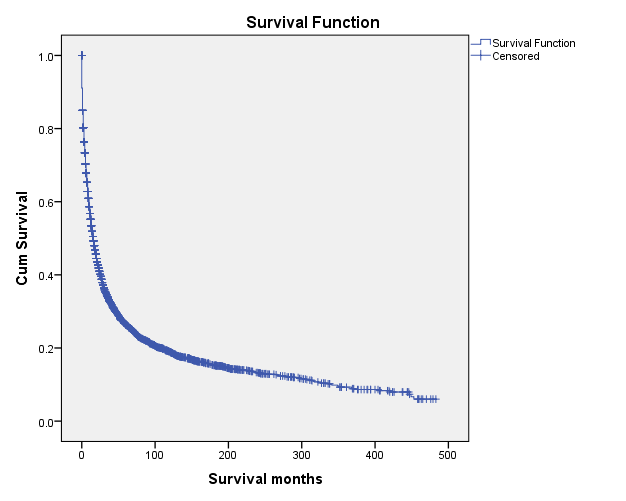Outcomes In Hemangiosarcoma - A Seer Based Study
Qi Yan, Mark G. Davies.
UT Health San Antonio, San Antonio, TX, USA.
OBJECTIVES: The management and outcome of Hemangiosarcoma, a rare malignant vascular tumor, is not well described. The aim of this study is to report the incidence, patient demographics, and outcomes based on national data.
METHODS: Data on patients with hemangiosarcoma were obtained from Surveillance, Epidemiology, and End Results (SEER) database. Statistical analysis was performed using Cox regression and Spearman correlation with SPSS.
RESULTS: 5070 patients (46.4%, male; age 66 ± 18yrs, mean ± SD) with hemangiosarcoma were identified in the SEER database between 1975-2006. The age-adjusted incidence rate was 0.1%-0.4%. Patients were mostly white (84%), followed by African American (8%), Asian or Pacific Islander (7%), American Indian/Alaska (0.4%), and unknown (0.7%). Average tumor size was 48 (IQR, 24-48) mm. Tumor grades were high at presentation (Grade I-10.5%; Grade II-16.2%; Grade III-34.8%; Grade IV-38.5%). Tumor extension was localized tumor in 48%, considered regional in 28%, and 24% had distant metastasis. The majority of patient underwent surgery (66.2%), others underwent either radiation or chemotherapy (16.9%), rest (16.9) received no treatment. In 5.6% of patients, surgery was recommended but not performed. At follow-up, 14.6% of patients were alive with a patient median survival of 13 (IQR, 3-41) months. Increasing age at diagnosis (P<0.001), female sex (P=0.005), left-sided tumor (P=0.013), larger tumor size (P<0.001), higher tumor Grade (P<0.001), greater tumor extension (P<0.001), single malignancy (P<0.001), not undergoing surgery (P<0.001), regardless of undergoing radiation therapy or chemotherapy, were associated with worse survival. The ethnicity of the patient and whether the tumor was the first primary malignancy were not statistically significant. There was a Five-year survival difference associated with gender (20%, SE=0.01 for male vs 32%, SE=0.01 for female; P<0.001). In patients where surgery was recommended, the five-year survival rate is 35% (SE=0.01) in patients underwent surgery versus 9% (SE=0.02) in patients who did not (P<0.001).
CONCLUSIONS: Incidence of hemangiosarcoma is low and long-term survival is poor. Female patients and those suitable for resection have a 4-fold increased survival at 5 yrs. While a rare tumor, surgical resection offered significant benefits over radiation or chemotherapy alone. 
Back to 2020 ePosters
